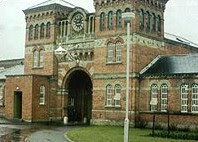Which
came first?
Wellington CollegeImage courtesy Wikimedia Commons
I live in
Berkshire, England, in a place called Crowthorne. It is a village, although the
part we live in is actually Wokingham Without, though what it lacks is not
specified.
The
village is quite large and is not an attractive, chocolate box spot with
thatched roofs and roses round the door. Photographs of it will never appear on
festive tins of shortbread. It’s more of a place people travel through to reach
somewhere else. Since the bypass was built, more than thirty years ago, most
travellers now don’t have to go anywhere near it.
Crowthorne
is known mainly for two institutions, at either end of the village. Wellington College, situated on four hundred acres near the station, which was specifically built to serve it, was originally
a boys’ independent school but is now fully co-educational.
It educates around 1100 students between the ages of thirteen and eighteen, who
enjoy superb facilities. Known principally as a boarding school, it also accommodates
day pupils. In common with many such establishments, its facilities are shared
with the local community and offer employment to local people. Boarding fees
are around £51,000 per annum. Day school fees are about £36,000.
Old Broadmoor HospitalImage courtesy Wikimedia Commons
At the other
end of the village, bordering the forest, is Broadmoor Hospital, the best-known
of England’s three high-security psychiatric hospitals. Though principally
known as a secure environment for dangerous criminals, it also treats men who
have never been convicted of criminal activity, but who pose a grave risk to
themselves and/or others. It has an annual turn-over of about fifty men and the
average age at admission is twenty-nine. Some stay for only a brief period,
others are discharged after five or six years. A small percentage, around 5%,
remain at the hospital for more than twenty years.
Some of
the more notorious inpatients have included the Yorkshire Ripper, who spent thirty
years in Broadmoor and the gangster, Ronnie Kray, both now dead.
Current
inmates include Michael Adebowale, convicted for murdering the British soldier,
Lee Rigby, in 2013, and Ian Ball, who was found guilty of attempting to kidnap Princess
Anne, now the Princess Royal, in 1974.
One of
the most interesting inmates was a retired American Army surgeon, W.C. Minor. He
fought in the American Civil War and afterwards moved to England. He suffered
from delusions and shot a man he suspected of breaking into his room. He was
not considered dangerous, but even so spent thirty-eight years in the hospital,
before being deported to the USA, where he died in Connecticut in 1920.
While at
Broadmoor, he was able to buy books from London booksellers and became aware of
the call for entries to what would become the Oxford English Dictionary.
Robert Maudsley
is a serial murderer once held in Broadmoor. He was the inspiration for Hannibal
Lecter.
It costs
between £200,000 to £300,000 per annum to accommodate a single patient in
Broadmoor. The warders, officially known as nurses, are tough individuals and
interesting characters to talk to. We sometimes meet one or two when we’re out
with the dogs. They often prove to have an enduring sense of humour, rather necessary
when dealing with damaged minds. It’s hard to find humanity in some who have
committed heinous crimes, but, as the Quakers advise, we must strive to find ‘that
of God’ in every human being.
A new hospital building was opened in 2019, after six years of construction. The old hospital
was a forbidding-looking red brick Victorian building, which was considered to
be no longer effective for modern psychiatric treatment. The new building is
light and airy, with attractive gardens. The aim is to rehabilitate patients,
not punish them for being ill.
Plans for
the old building, which is Grade II listed and cannot be demolished without official
consent, include redeveloping the sixty acre site, with new homes and new apartments
for older people, converting fifty-six apartments in the original building, and
providing a care home for sixty people.
When we
first moved to Crowthorne and for many years after, 10.00 am on a Monday morning
was the time for the Broadmoor klaxon to be tested. People set their watches by
it. The sirens were decommissioned around 2018, to be replaced by alerts
through social media, radio, and television. I’m not sure how effective those
alerts are. Not everyone listens to local radio or watches television. I
suppose mobile ‘phones are better equipped to warn people, but I still think a
wailing siren is harder to ignore.
Escapes are
rare. The last serious one was attempted by a child rapist in 1991. Road blocks
were set up and all vehicles were stopped and checked. Barry had just arrived
at the forest, ready for a run with the dogs. On the track leading into the trees,
the police had erected a tape, on the understanding, presumably, that no-one
escaping would think to go either side of it. They stopped Barry and showed him
a photograph of the inmate and said, ‘If you see him, run back here and tell
us.’
Barry
didn’t see him, and the patient was recaptured two days later.
So, which
came first? Both were Victorian establishments.
Broadmoor
Hospital was built in 1863, and the first patients were women.
The foundation
stone for Wellington College was laid by Queen Victoria in 1856, and the first
pupils entered in 1859. It was built as a monument to the Duke of Wellington,
the ‘Iron Duke,’ and was intended to educate the orphaned sons of army officers
killed in battle.
(Can you be an orphan if one parent is still alive? You can
if the deceased parent was the major family support.)






.jpg)
















_underside.jpg)
_underside.jpg)










.jpg)



_(cropped).jpg)
